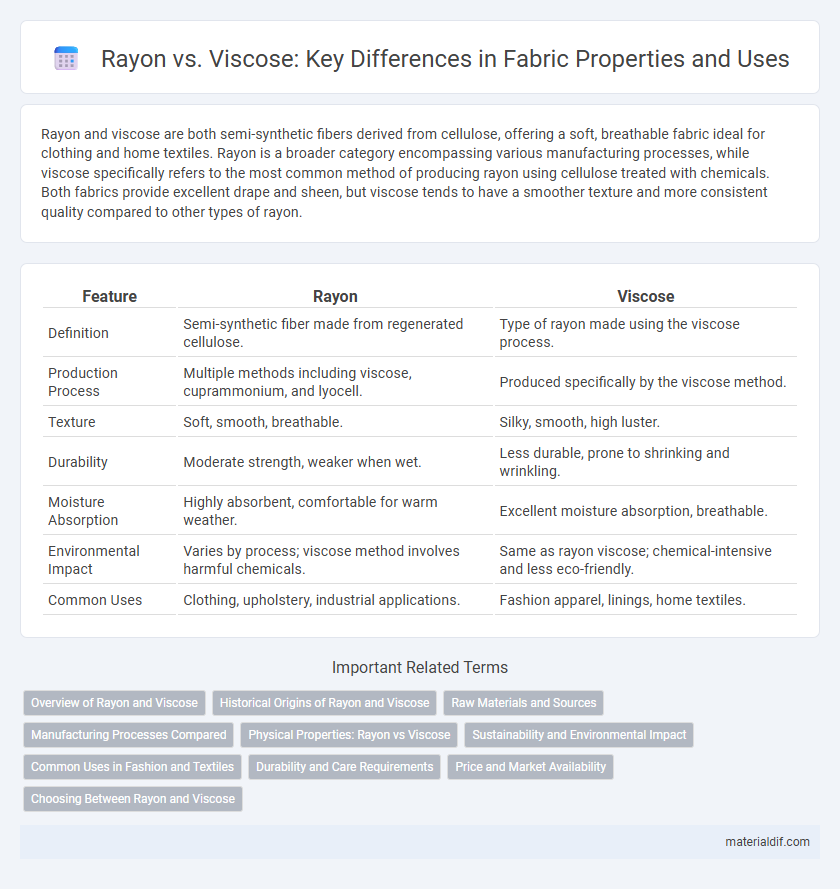Rayon and viscose are both semi-synthetic fibers derived from cellulose, offering a soft, breathable fabric ideal for clothing and home textiles. Rayon is a broader category encompassing various manufacturing processes, while viscose specifically refers to the most common method of producing rayon using cellulose treated with chemicals. Both fabrics provide excellent drape and sheen, but viscose tends to have a smoother texture and more consistent quality compared to other types of rayon.
Table of Comparison
| Feature | Rayon | Viscose |
|---|---|---|
| Definition | Semi-synthetic fiber made from regenerated cellulose. | Type of rayon made using the viscose process. |
| Production Process | Multiple methods including viscose, cuprammonium, and lyocell. | Produced specifically by the viscose method. |
| Texture | Soft, smooth, breathable. | Silky, smooth, high luster. |
| Durability | Moderate strength, weaker when wet. | Less durable, prone to shrinking and wrinkling. |
| Moisture Absorption | Highly absorbent, comfortable for warm weather. | Excellent moisture absorption, breathable. |
| Environmental Impact | Varies by process; viscose method involves harmful chemicals. | Same as rayon viscose; chemical-intensive and less eco-friendly. |
| Common Uses | Clothing, upholstery, industrial applications. | Fashion apparel, linings, home textiles. |
Overview of Rayon and Viscose
Rayon and viscose are both semi-synthetic fabrics derived from cellulose fibers, primarily sourced from wood pulp. Rayon typically undergoes a different chemical processing method compared to viscose, resulting in variations in texture, durability, and breathability. Viscose is a type of rayon known for its silky appearance and soft feel, commonly used in apparel and upholstery for its lightweight and moisture-absorbing properties.
Historical Origins of Rayon and Viscose
Rayon and viscose share a closely linked history, with rayon first developed in the late 19th century as the first semi-synthetic fiber derived from cellulose. Viscose refers specifically to the process patented by British chemist Charles Frederick Cross in 1894, which revolutionized the commercial production of rayon by transforming cellulose into a soluble viscous solution. This innovation laid the foundation for modern rayon fabrics, expanding textile manufacturing beyond purely natural fibers.
Raw Materials and Sources
Rayon is a semi-synthetic fiber derived primarily from cellulose found in wood pulp, bamboo, or cotton linters, whereas viscose is a specific type of rayon manufactured through a chemical process that converts cellulose into a soluble compound before regenerating it into fiber. Both fibers originate from natural sources like hardwood trees, but viscose production often involves more chemical treatment, making it a subset of rayon. The raw material quality and processing methods distinguish the two, impacting their texture, durability, and environmental footprint.
Manufacturing Processes Compared
Rayon and viscose both originate from cellulose fibers but differ in manufacturing processes, with rayon produced using the viscose method involving cellulose xanthate dissolution and subsequent regeneration into fibers. Viscose specifically refers to this chemically intensive viscose process that treats cellulose with sodium hydroxide and carbon disulfide to create a soluble compound before fiber formation. Manufacturing rayon can also include alternative processes like the lyocell method, which uses an organic solvent for a more environmentally friendly production compared to the traditional viscose route.
Physical Properties: Rayon vs Viscose
Rayon and viscose share similar physical properties as both are semi-synthetic fibers derived from cellulose, offering a soft texture and high absorbency. Rayon typically exhibits greater strength and durability compared to viscose, which tends to have a more delicate and silk-like feel. Both fibers are breathable and drape well, but rayon often provides better wrinkle resistance and resilience during washing.
Sustainability and Environmental Impact
Rayon and viscose, both semi-synthetic fibers derived from cellulose, differ significantly in sustainability and environmental impact. Viscose production often involves toxic chemicals like carbon disulfide, contributing to air and water pollution, whereas modern rayon manufacturing adopts closed-loop processes that reduce harmful emissions and improve biodegradability. Choosing sustainably produced rayon or viscose with certifications such as FSC or OEKO-TEX helps minimize ecological footprint and supports responsible forest management.
Common Uses in Fashion and Textiles
Rayon and viscose are widely used in fashion and textiles for their soft texture and breathability, making them popular choices for summer clothing, linings, and blouses. Rayon is favored for its durability and ability to mimic silk, often found in dresses, suits, and sportswear, while viscose, being more absorbent and lightweight, is commonly used in casual wear, scarves, and linings. Both fabrics support vibrant dye absorption, enhancing their appeal in colorful garments and fashion accessories.
Durability and Care Requirements
Rayon and viscose are both semi-synthetic fibers derived from cellulose, but rayon generally offers better durability due to its stronger fiber structure, making it more resistant to wear and tear. Viscose has a softer feel but tends to weaken when wet, requiring gentle handling and delicate washing to maintain its integrity. Care for rayon involves cool water washing and air drying, while viscose demands even more cautious care, often needing hand washing or dry cleaning to prevent shrinkage and damage.
Price and Market Availability
Rayon generally commands a higher price than viscose due to its more complex manufacturing process and higher quality fibers. Viscose, widely available in various markets, is often favored for its affordability and versatility in producing lightweight, breathable fabrics. Market availability of viscose surpasses rayon, making it the more accessible option for budget-conscious consumers and bulk textile production.
Choosing Between Rayon and Viscose
Rayon and viscose are both semi-synthetic fibers derived from cellulose but differ in processing methods and fabric qualities; viscose tends to be softer and more lustrous, making it ideal for lightweight garments. When choosing between rayon and viscose, consider factors such as breathability, drape, and durability since viscose offers higher moisture absorption while rayon is typically more affordable. The decision depends on the desired texture, garment type, and care requirements, as viscose often demands gentler handling compared to rayon.
Rayon vs Viscose Infographic

 materialdif.com
materialdif.com